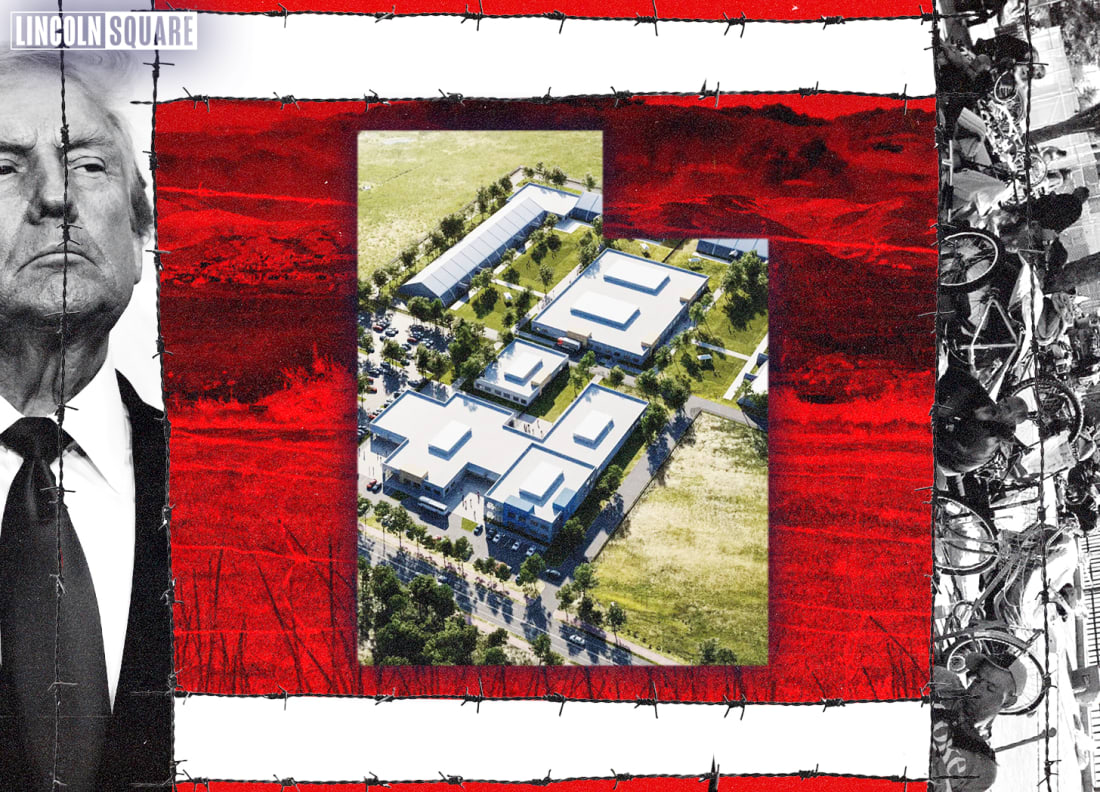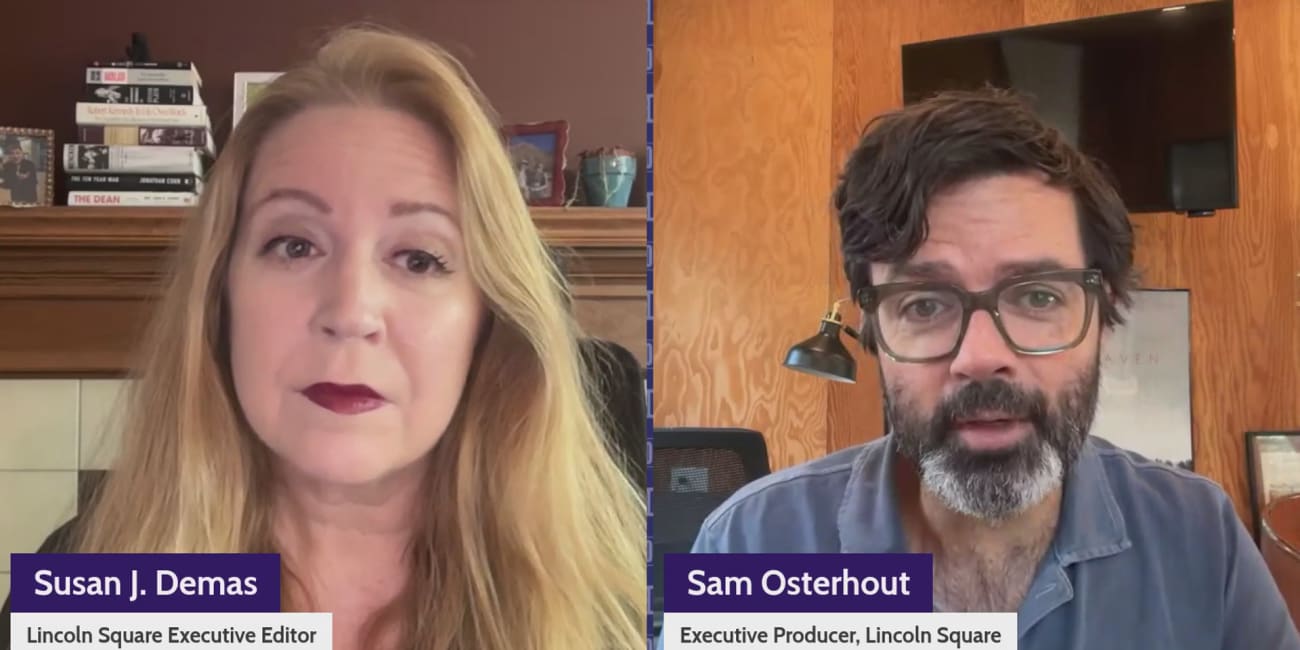|
 |
Thank you for being a free subscriber.. Don’t lose access to Lincoln Square. If you upgrade right now, you can lock in 20% off your annual subscription to one of the fastest-growing pro-democracy communities on Substack!
Your subscription upgrade helps us inform disengaged voters with the facts to mobilize them into action!
Inside Trump's Homeless Lockup in Utah
Authorized under Trump’s 2025 order, Utah’s 16-acre, state-run campus will hold about 1,300 unhoused people—many under court mandate—within a fenced facility where residents cannot freely leave.
On the northern edge of Salt Lake City, trucks hum past wheat stubble and the thin lines of new survey stakes. Here, Utah is building what officials describe as a compassionate response to homelessness: a sixteen-acre, state-run campus designed to house about 1,300 people with nowhere else to go. The site, once pastureland, will soon hold dormitories, treatment centers and perimeter fencing—a complex presented as humane yet disciplined. Whether it becomes a sanctuary or a segregation remains to be seen.
The initiative fits within a broader federal directive. In July 2025, President Donald Trump issued an executive order titled Ending Crime and Disorder on America’s Streets, instructing states to “get the homeless off our streets” and to create treatment zones on “large parcels of inexpensive land.” During his campaign, Trump described major cities as “unsanitary nightmares” and promised to “open up land where dangerously deranged people can be relocated and their problems identified.” Utah is among the first states to act on that mandate.
Standing on the marked field, Randy Shumway, chair of the Utah Homeless Services Board, called the project “transformative.” Plans reserve hundreds of beds—roughly 300—for people under civil commitment or court-ordered treatment. Supporters say the model could save lives otherwise lost to exposure or overdose. Critics caution that a locked, state-run compound may function less as a hospital than as a holding zone. Officials emphasize clinical oversight, though limited public-transit access has raised doubts about how easily residents might re-enter city life.
Local reporting describes a months-long, opaque planning process, and state documents highlight security staffing, fencing and zoning for behavioral-health compliance. The language of care overlaps with that of control, suggesting what some analysts view as a program meant as much to manage disorder as to relieve it. The president’s rhetoric—casting homelessness as both tragedy and threat—resonates in the project’s design.
When aerial maps of the site appeared in local news coverage, they showed open ground bordered by warehouses and rail spurs, a literal edge of the city. One columnist described the compound as “a city of the excluded on the city’s edge.” That geography reflects, historians say, a long-standing administrative habit: moving social problems to the periphery.
Historians note that versions of this strategy have surfaced before. In the nineteenth century, county poor farms offered shelter in exchange for labor; in Britain, workhouses confined the destitute for moral correction. Reform colonies in the early twentieth century sought to quarantine poverty from public view. Under the Nazi regime, people labeled “asocial” or “work-shy” were swept up in Aktion Arbeitsscheu Reich and sent to concentration camps in a campaign to sanitize cities—a history documented by the United States Holocaust Memorial Museum. The moral distance from that past is vast, but the administrative assumption endures: that disorder can be mitigated by separating the disordered.
Across centuries, the settings and justifications have shifted, yet the civic reflex has not. What was once moral discipline is now administrative hygiene—the belief that social ills can be managed by moving them. When governments treat homelessness as an eyesore to be hidden rather than a condition to be addressed, the instruments change—fences instead of stone walls, clinical forms instead of parish registers—but the impulse endures.
Scholars of welfare governance describe that impulse as an enduring civic habit: the drive to make hardship invisible. From the “asocial” roundups of the 1930s to modern encampment bans and containment zones, governments faced with inequality have often managed its appearance rather than its cause. In an economy defined by privatized housing and precarious wages, homelessness mirrors a structural fracture, not a personal failure. When faced with problems too large to ignore, the state often relocates them instead. Sidewalks clear, but inequality remains.
That reflex is not born of impossibility but of decision. Homelessness can be reduced by providing housing; addiction can be treated through care; mental illness can be managed through programs that match need to support. Each requires investment and patience—commodities in short political supply. Critics argue that the administration has chosen a cheaper route: to clear the streets without curing the causes, achieving the semblance of order without the substance of repair.
Federal data reinforce the pressures feeding this approach. A 2024 report from the Department of Housing and Urban Development recorded an 18 percent rise in homelessness over the previous year—the steepest increase on record. Economists attribute the surge to rents outpacing wages and to a continuing shortage of affordable units left in the pandemic’s wake. Surveys conducted early in 2024 found that about two-thirds of Americans live paycheck to paycheck. Numbers like these transform abstraction into urgency, fueling what analysts describe as a politics of impatience: when remedies require resources, visibility becomes the easier target.
That impatience soon found political voice. During his campaign, the president pledged to “root out” opponents who “live like vermin” and warned that immigrants were “poisoning the blood of our country.” Earlier, he had boasted that he could “stand in the middle of Fifth Avenue and shoot somebody” without losing support—a line that framed dominance as moral proof. Within that worldview, removing visible poverty is not negligence but performance: a display of control that passes for order.
A similar logic has appeared in gentler tones elsewhere. Robert F. Kennedy Jr., for example, has advanced his proposal for “wellness farms,” rural compounds where people struggling with addiction—or even those taking antidepressants—would be sent for “re-parenting,” financed through cannabis-tax revenue. The plan revives the moral reasoning of the reformatory and the temperance colony: isolation reimagined as therapy. Kennedy calls it benevolence; critics call it coercive care.
Both efforts, scholars suggest, express the same administrative reflex under different banners. Sociologist Loïc Wacquant has written that modern states oscillate between welfare and punishment—offering aid only within surveillance. When insecurity widens, compassion contracts, and governance drifts toward control disguised as care.
Utah’s plan illustrates that tension in miniature. Supporters insist that containment and compassion can coexist, pointing to lives saved from hypothermia, overdose and street violence. Dissenters counter that involuntary treatment rarely endures beyond the moment of custody, producing cycles of release and return. Federal reviews of Housing First programs show the opposite pattern: lower mortality, fewer emergency-room visits and sustained cost savings when housing precedes therapy. Evidence for compulsory models, by contrast, remains fragmentary.
Budget choices offer a parallel measure. In Utah’s 2025 fiscal plan, legislators boosted funding for public safety and encampment abatement, while allocations for affordable housing stayed largely flat. To advocates, the imbalance turns compassion into choreography—empathy performed for the securely housed. The policy, like the federal order that inspired it, measures progress by what disappears rather than what endures: tents, not trauma; symptoms, not causes.
That logic extends beyond Utah. Across the industrialized world, governments faced with visible poverty alternate between inclusion and removal, often describing the latter as reform. What distinguishes the present moment is its polish. Where nineteenth-century workhouses relied on brick and iron, their twenty-first-century heirs deploy biometric gates, surveillance drones and digital dashboards. The ethic remains the same: to manage disorder until it no longer appears.
For now, the field north of Salt Lake City is quiet except for the low hum of freight trucks on the highway. Officials have floated a 2027 opening, though deadlines have already slipped. The grass will give way to concrete, then to dormitories and treatment wards. Whether the complex becomes a refuge or a repository will depend less on its architecture than on its intent. The blueprint leaves one question unresolved: when government promises to rescue the vulnerable, does it mean to bring them home—or merely to move them out of view?
Brian Daitzman is the Editor of The Intellectualist. Read the original article here.
References
The White House (Executive Order) — Jul 24, 2025 — Ending Crime and Disorder on America’s Streets — https://www.whitehouse.gov/presidential-actions/2025/07/ending-crime-and-disorder-on-americas-streets/ White House
Utah Office of Homeless Services — 2025 — Homeless Campus (project hub & materials) —
https://homelesscampus.utah.gov/
Utah News Dispatch — Sep 3, 2025 — Utah officials unveil site for 1,300-bed homeless campus after long, secretive search — https://utahnewsdispatch.com/2025/09/03/utah-homeless-campus-site-unveiled-after-secretive-search/ Utah News Dispatch
Axios Salt Lake City — Sep 3, 2025 — Utah selects site for 1,300-bed homeless services campus — https://www.axios.com/local/salt-lake-city/2025/09/03/utah-homeless-services-campus-site-northpoint-beds Axios
HUD (AHAR Part 1) — Dec 2024 — 2024 AHAR: Point-In-Time Estimates of Homelessness in the U.S. — https://www.huduser.gov/portal/datasets/ahar/2024-ahar-part-1-pit-estimates-of-homelessness-in-the-us.html HUD User
PYMNTS/LendingClub — Feb–Mar 2024 — New Reality Check: The Paycheck-to-Paycheck Report (PDF) — https://www.pymnts.com/wp-content/uploads/2024/02/PYMNTS-New-Reality-Check-February-March-2024.pdf PYMNTS
The Independent (UK) — Jul 25, 2024 — RFK Jr thinks government should send “addicts” to tech-free “wellness farms” — https://www.independent.co.uk/news/world/americas/us-politics/rfk-jr-kennedy-addicts-wellness-farms-b2585835.html The Independent
Pain News Network — Jan 20, 2025 — RFK Jr. Wants to Create Drug Rehab “Wellness Farms” — https://www.painnewsnetwork.org/stories/2025/1/20/rfk-jr Pain News Network
Duke University Press (scholarship) — 2009 — Loïc Wacquant, Punishing the Poor: The Neoliberal Government of Social Insecurity — https://read.dukeupress.edu/books/book/1399/Punishing-the-PoorThe-Neoliberal-Government-of Duke University Press
Utah News Dispatch — Oct 2, 2025 — Utah homeless board proposes ‘initial framework’ to respond to Trump’s executive order — https://utahnewsdispatch.com/2025/10/02/utah-homeless-board-proposes-initial-framework-to-respond-to-trumps-executive-order/ Utah News Dispatch
Utah Homeless Services Board — August 18, 2025
Meeting Minutes: “Campus Development Update and Site Criteria Discussion.”
🔗 https://www.utah.gov/pmn/files/1330075.pdf
(Index page: https://www.utah.gov/pmn/sitemap/noticehistory/239503.html)Standard-Examiner — September 18, 2025
“Utah’s New Homeless Campus Should Have 300-plus Beds for Civil Commitment, Board Chair Says.”
🔗 https://www.standard.net/news/local/2025/sep/18/utahs-new-homeless-campus-should-have-300-plus-beds-for-civil-commitment-board-chair-says/Utah Legislature — FY 2025–2026 Budget (LFA)
Budget Publications Hub: https://le.utah.gov/lfa/publications.html
Hearing Deck (PDF): https://le.utah.gov/interim/2025/pdf/00002339.pdfNational Alliance to End Homelessness — 2024
“Housing First” Explainer: https://endhomelessness.org/resources/toolkits-and-training-materials/housing-first/
“Housing First Fact Sheet” (PDF): https://endhomelessness.org/wp-content/uploads/2022/08/Housing-First-Fact-Sheet_Aug-2022.pdf
HUD 2024 AHAR Press Note: https://endhomelessness.org/media/news-releases/hud-releases-2024-annual-homelessness-assessment-report/Larsen, Christian A. (2016)
“The Poorhouse Revisited: Welfare and Social Control in Historical Perspective.”
Social Policy & Administration, 50 (2): 129–147.
🔗 https://doi.org/10.1111/spol.12122ACLU of Utah — March 2025 (Substitute for Campus Statement)
Press Release: “Comment on HB465 Encampment Clearing Mandate.”
🔗 https://www.acluutah.org/press-releases/comment-hb465-encampment-clearing-mandate/Detlev J. K. Peukert (Yale University Press) — 1987 — Inside Nazi Germany: Conformity, Opposition, and Racism in Everyday Life — https://yalebooks.yale.edu/book/9780300044805/inside-nazi-germany/
Nikolaus Wachsmann (Macmillan / FSG) — 2015 — KL: A History of the Nazi Concentration Camps — https://us.macmillan.com/books/9780374535926/kl/ Macmillan
United States Holocaust Memorial Museum (USHMM) — n.d. — “Asocial Prisoners in the Nazi Concentration Camps” — https://encyclopedia.ushmm.org/content/en/article/what-groups-of-people-did-the-nazis-target
Soss, Joe & Schram, Sanford F. (Social Policy & Administration) — 2007 — “The Neoliberal Turn in Welfare Governance: Disciplining the Poor?” — https://press.uchicago.edu/ucp/books/book/chicago/D/bo12120768.html
The National Archives (UK) — 2024 — “Workhouse Life: The Poor Law and the Origins of the Welfare State” — https://www.nationalarchives.gov.uk/education/resources/1834-poor-law/
Organisation for Economic Co-operation and Development (OECD) — Mar 2024 — Income Inequality Update 2024 — https://www.oecd.org/social/income-distribution-database.htm
You’re currently a free subscriber to Lincoln Square Media. For full access to our content, our Lincoln Loyal community, and to help us amplify the facts about the assault on our rights and freedoms, please consider upgrading your subscription today with this limited-time offer. Lock in this special rate today.
Not ready to subscribe? Make a one-time donation of $10 or more to support our work amplifying the facts on social media, targeted to voters in red states and districts that we can help flip. Every $10 reaches 1000 Americans. The Truth needs a voice. Your donation will help us amplify it.
Want to help amplify this post? Please leave a comment and tell us what you think.

